Kimchi is one of the oldest fermented foods and it is the major fermented food in Korea. Kimchi is mentioned in ancient Korean book “Samkuksaki,” published in 1145 A.D. It is made from a chines cabbage (latin name is Brassica rapa L. spp. pekinensis) and radish as main ingredients. The fermentation process is pretty simple and short. There are a number of different varieties of kimchi dependent on what ingredients, typically vegetables are used. It is one of the numerous probiotic bacteria rich foods!
Variety is always the key when it comes to ones microbiome. What I love about kimchi is a totally different taste and flavor from other fermented foods. And increased variety of vegetables – especially fermented vegetables – is only beneficial. It’s not only about the taste but also about the composition. First of all one can ferment different types of vegetables with this cabbage which will increase the variety fiber. Second, the microbial composition. Can’t emphasise enough that its extremely good to consume different types of fermented foods because they have a lot of good bacteria but also they produce a lot of beneficial for our health compounds. And different fermented foods have DIFFERENT good bacteria. Actually the fermentation process is pretty cool and even little differences like the amount of salt, temperature, extra ingredient can effect the composition. So one batch of the “same” fermented food can have a different composition. So the more different fermented foods you will have the better it is. You can check how milk kefir and kombucha can complement bacteria that are present in kimchi.
These are bacteria that often are found in kimchi. This particular study tested over 80 different kimchi samples and found that the most abundant genera of bacteria are:
- Lactobacillus (interesting fact this these bacteria were more abundant in homemade kimchi than industrial based on the research and we know that there are a lot of probiotic bacteria among Lactobacilli so it looks like homemade kimchi maybe the way to go)
- Leuconostoc mesenteroides
- Leuconostoc gelidum
- Leuconostoc citreum
- Leuconostoc camosum
- Leuconostoc gasicomitatum
- Leuconostoc kimchii
- Weissella koreensis
- Lactococcus sakei
- Lactobacillus casei
- Lactobacillus plantarum
- Pseudomonas
- Allium hookeri
other bacteria present are:
- Psycrobacter
- Hafnia
- Enterobacter
- Rahnella
- Pantoea
I have to say that microbial composition is pretty amazing. I love that it has so many different lactobacilli.
Now what are the benefits of this microbe rich fermented chinese cabbage? This image below illustrates all the benefits that have been scientifically demostrated.

Image taken from the following article.
Here is schematic representation of preparation method published in the recent scientific review.
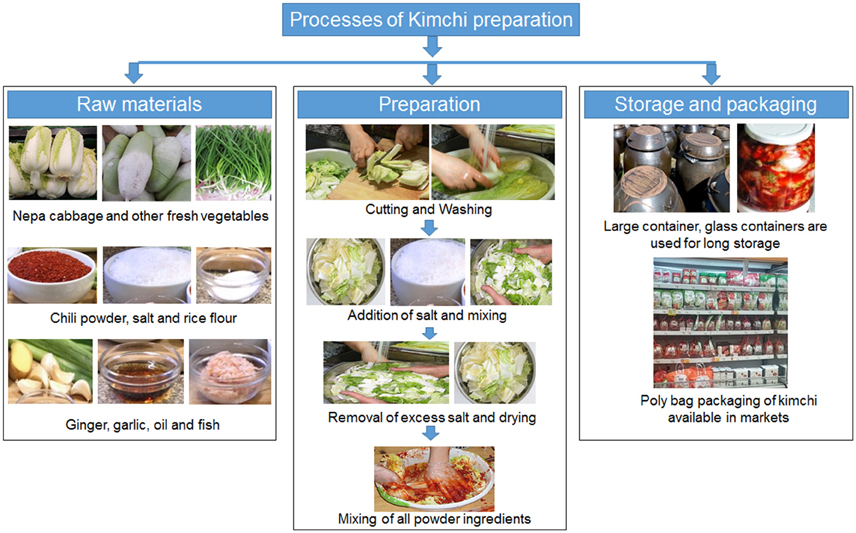
Image taken from the following article
There are many right ways to prepare kimchi at home. It all depends on personal taste and family traditions. Here is my recipe. I come from the culture of no spicy food whatsoever so my version of kimchi is not very spicy. You can always experiment and add more spice to it. And I used all organic ingredients.
Equipment:
Glass jars (1L)
Plate to use for the press
Quart (1L) measuring cup
Mandoline slicer and shredder
Knife
Ingredients:
1 large chopped napa cabbage
1 8 oz Japanese Daikon raddish
1 large carrot
6 scallions
1/2 Korean (or Asian) pear
1/2 minced garlic head
1 tbsp minced ginger
1 tbsp chilli pepper flakes (or traditional gochugaru powder or flakes)
1 tsp sugar
4 tbsp Himalayan salt
1 tbsp fish sauce
STEP 1
Wash napa cabbage and cut it into pieces. You can discard the upper leaves.
STEP 2
Make sure you have all your dishes cleaned and rinsed very well, preferably sanitised in the dishwasher too. Soak the cabbage in salty water overnight under the press. I put the plate on top of the cabbage and place a big jar filled with water as a weight.
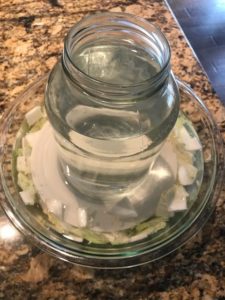
STEP 3
Rinse thoroughly the cabbage next day reserving some of the cabbage “brine” (salty water). Dry the cabbage as much as possible.
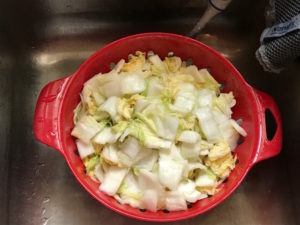
STEP 4
Slice daikon radish. I love my Chef’s Inspiration mandoline for slicing. To protect your fingers from cutting you can use these gloves. I using it for both slicing and shredding.
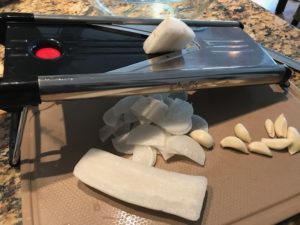
STEP 5
Shred the carrot. I used again Chef’s Inspiration mandoline.
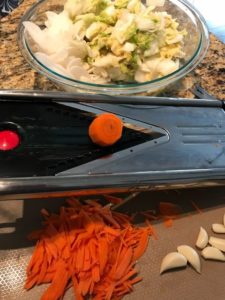
STEP 6
Shred half of the avian pear or Korean pear. On the left
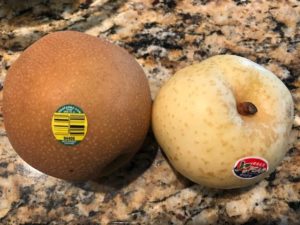
Shredded Korean pear for kimchi
STEP 7
Cut the scallions into 1 inch pieces.
STEP 8
Set aside the vegetables and prepare the paste. Mix minced garlic, minced ginger and peppers together to form uniform paste. You can add 1 tsp of sugar although it is optional. Sugar will just speed the fermentation process. Instead of fermenting 10 days you may need to ferment only 7 days.However it all depends on other conditions like temperature, humidity, volume, ingredients etc., even time of the year may play a role. By the end of fermentation there won’t be any sugar left so don’t worry if you are cautious about sugar.
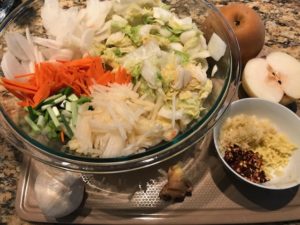
STEP 9
Mix paste into the veggies. Make sure all vegetables are covered in paste equally.
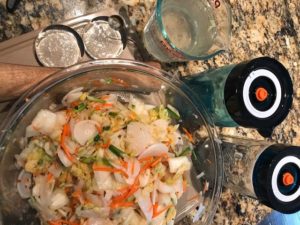
STEP 10
Pack all the veggies into glass jars. I use these wide mount mason jars. And cover with the easy fermenter lids. These lids are awesome. You can let the forming from fermentation air out without opening them. You can also set the dat on the lid that will remind you when you started the fermentation. It’s super useful because I tend to forget these details. Make sure you leave some room on he top of the jar – at least an inch or so.
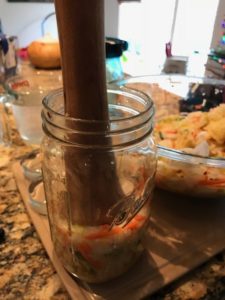
STEP 11
Leave to ferment for at least 3-5 days. You can check on it to make sure there is no mood growing. Don’t worry if you use clean sanitised dishes and good quality produce you should not have to deal with these type of issues. After you think it is ready you can move it into refrigerator. It should be good for at least one month. In old times it lasted all winter.
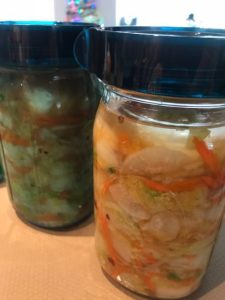
STEP 12
Enjoy this probiotic and prebiotic rich superfood.
If you liked this recipe, you might like to check out these other fermentation based recipes.

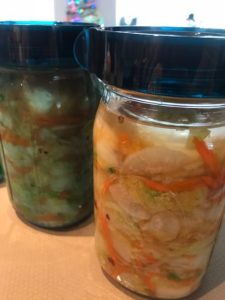
I like what you said that kimchi has a lot of benefits. Now that I’m trying to eat healthier foods to reduce my risk of heart failure, I’m glad I came across your article. I never knew that it contains Lactobacillus that is proven to be richer in homemade kimchi. I guess I shall then purchase vegan kimchi for sale and mix it with my current meal plan for an effective diet scheme.
Victoria, I am so happy you found the information useful. Definitely introduce as many fermented foods in your regimen as you can. Your microbiome will thank you for that!
Do you know which strands of Lactobacillus other than Plantarum are most commonly found in kimchi? I am trying to have my child avoid taking specifically the Casei and Bulgaricus strands.
Hello Grace! Thank you for your message. I have included the list of bacteria in the beginning of the article. Lactobacillus casei is another one that is commonly found. I will be soon updating all my recipes because there is new research data emerging. Stay tuned!